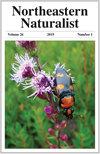Sometimes You Can Add a Bit of Salt: Additional Freshwater Insect Species in Canadian Estuaries
IF 0.5
4区 环境科学与生态学
Q4 BIODIVERSITY CONSERVATION
引用次数: 1
Abstract
Abstract - Along the river–ocean transition, few freshwater species persist into polyhaline zones. Among those insect species capable of living in estuaries, it is unclear which Odonata, Trichoptera, and Coleoptera species can occur at intermittent or average salinities above 18 PSU. During surveys of fish and crustaceans in Prince Edward Island (PEI), we noted 3 unexpected insect species from within subtidal-channels. Multiple instars of Coenagrionidae n. det. and Enallagma civile (Familiar Bluet) were collected around marine macroalgae at 5 localities with 6-26 PSU salinities and observed emerging atop macroalgae. Also, collections of the larvae of the caddisfly Limnephilus externus (Limniphilidae), and adult Haliplus cribrarius (Haliplidae) beetles at sites with maxima of 23 and 20 PSU, respectively, suggest rare occurrences of these species within estuarine ecotones.有时你可以加一点盐:加拿大河口的其他淡水昆虫物种
摘要-在河流-海洋的过渡过程中,很少有淡水物种存在于多盐区。在那些能够生活在河口的昆虫物种中,尚不清楚哪种蜻蜓目、毛翅目和鞘翅目物种可以出现在间歇性或平均盐度超过18PSU的环境中。在爱德华王子岛(PEI)的鱼类和甲壳类动物调查中,我们注意到潮下通道内有3种意想不到的昆虫。在具有6-26 PSU盐度的5个地点,在海洋大型藻类周围采集了Coenagrionidae n.det.和Enallagma civile(熟悉蓝)的多龄幼虫,并观察到它们在大型藻类顶部出现。此外,在最大值分别为23和20 PSU的地点采集到的石鳖(Limniphilidae)和成年筛状Haliplus甲虫(Haliplidae)的幼虫表明,这些物种在河口交错带内罕见出现。
本文章由计算机程序翻译,如有差异,请以英文原文为准。
求助全文
约1分钟内获得全文
求助全文
来源期刊

Northeastern Naturalist
环境科学-生态学
CiteScore
1.10
自引率
0.00%
发文量
42
审稿时长
18-36 weeks
期刊介绍:
The Northeastern Naturalist covers all aspects of the natural history sciences of terrestrial, freshwater, and marine organisms and the environments of the northeastern portion of North America, roughly bounded from Virginia to Missouri, north to Minnesota and Nunavut, east to Newfoundland, and south back to Virginia. Manuscripts based on field studies outside of this region that provide information on species within this region may be considered at the Editor’s discretion.
The journal welcomes manuscripts based on observations and research focused on the biology of terrestrial, freshwater, and marine organisms and communities as it relates to their life histories and their function within, use of, and adaptation to the environment and the habitats in which they are found, as well as on the ecology and conservation of species and habitats. Such studies may encompass measurements, surveys, and/or experiments in the field, under lab conditions, or utilizing museum and herbarium specimens. Subject areas include, but are not limited to, anatomy, behavior, biogeography, biology, conservation, evolution, ecology, genetics, parasitology, physiology, population biology, and taxonomy. Strict lab, modeling, and simulation studies on natural history aspects of the region, without any field component, will be considered for publication as long as the research has direct and clear significance to field naturalists and the manuscript discusses these implications.
 求助内容:
求助内容: 应助结果提醒方式:
应助结果提醒方式:


